RBI’s unwise dividend payout to the government
By RN Bhaskar
On 22 May 2024, the Reserve Bank of India (RBI) announced that it would be paying to the government a whopping sum of Rs.2.11 lakh crore rupees by way of dividend. You can view this announcement here https://www.youtube.com/watch?v=CLPbuFyUuaY . The buzz that this has created among banking circles and among economists ranges from approval to anxiety. The following paragraphs deal with these issues.
The quantum of dividend that the RBI ought to pay to the government was probably the cause which led to the resignation of Urjit Patel, former governor of the central bank in 2018. This was followed by the resignation of Viral Acharya, deputy governor of the bank. In September 2023, Acharya disclosed that it was the government demand for Rs. 2-3 lakh crore by way of dividend that triggered the resignations (https://economictimes.indiatimes.com/news/economy/policy/rbi-resisted-govt-push-for-rs-3-lakh-cr-transfer-in-2018-ahead-of-elections-viral-acharya/articleshow/103464033.cms?from=mdr). He described the government’s move a backdoor monetization of the fiscal deficit by the central bank. Clearly, the current governor of the RBI thinks that such a dividend payout is okay. In fact, it is the largest ever payout by the central bank to the government.
Unlike Patel and Acharya, the present governor, Shaktikanta Das, may be more comfortable about transferring RBI’s surpluses to the government. His term is to expire this year. Moreover, there are many issues that this transfer raises. They make the RBI complicit in the damage that such transfers could cause to the Indian economy.
First, the transfer allows the government to conceal its deficit financing. In other words, the RBI is helping the government window dress its accounts.
That may not be a bad thing, if the money is being used for capital formation, for infrastructure building, for purposes that result in more wealth generation for the country, or for creating more jobs. India has a huge problem of acute unemployment — among the largest levels in the country. But much of the money has been used for non-productive purposes. Even investment in infrastructure has been politically driven, not based on economic considerations as the government’s implementation of the two Dedicated Freight Corridors shows (free subscription — https://bhaskarr.substack.com/p/indias-two-dfcs-politics-trounces).
The RBI should also have considered that the government has squeezed additional dividends from almost every public sector unit in the country. It has taken 1.24 lakh crore from listed central government PSUs (https://www.business-standard.com/industry/news/listed-cpsus-to-pay-record-high-equity-dividend-of-rs-1-26-trillion-in-fy24-124053101332_1.html). The additional amounts from non-listed PSUs remain unquantified. This means that the PSUs will be left with little money to carry out expansions or normal expenditure on wear and tear and even replacement of machinery. This could lead to underperformance of the PSUs in the coming years, causing a further drain on the economy. It will further exacerbate unemployment pains and even shrink the middle class (free subscription – https://bhaskarr.substack.com/p/the-shrinking-growth-of-the-middle)
The RBI, as one of the most powerful institutions in the country, could have attempted restraining this practice. But clearly, wiser counsels must have prevailed.
And this leads us to the second problem. Much of the money the government spends is on subsidies. Do pay attention to the way the subsidies have ballooned under Modi 2.0 (https://indianexpress.com/article/explained/explained-economics/subsidies-under-modi-2-0-lok-sabha-elections-9132095/).
What makes the situation worse is that the government has already announced that many of these subsidies will continue for the next five years.
That in turn results in two problems.
- First these spends crowd out money that could have been used for capital formation and job creation. They are essentially unproductive.
- Second, when subsidies are given for a very short period, when there is a crisis, that can be justified. But when they are offered over extended periods of time, they cripple an entire generation. Recipients of doles then prefer to live on freebies because they have lost their ability to work. Their appetite for “revadis” (the government’s contemptuous reference to such doles) is akin to the craving for drugs by an addict. The government, with the RBI as an abettor, has actually driven an entire potential working class into subsidy addiction.
To appreciate how serious this could be, just listen to Danielle DiMartino Booth in the Mauldin Economics podcast. from timeline 16:33 to 22:00 at https://www.youtube.com/watch?v=5BXS3hVfVO4 .
It is then that you begin to realise how debilitating the killing of the desire to work can be for an economy like the US. India is in a worse situation, because we already have unemployment, poor capital formation, little education and poor health services. We are destroying even existing jobs by teaching people not to work. We are making cripples of our working population.
This would not have been that serious had India been a good destination for foreign Direct Investment (FDI). But the fact is that India’s FDI inflow is at its lowest since 2007 (https://www.livemint.com/economy/mint-explainer-why-is-indias-net-fdi-at-its-lowest-level-since-2007-11716959905836.html). The way the government has weaponised its law enforcement authorities has made at least 35,000 high networth individuals (HNIs) flee the country’s shores (https://www.telegraphindia.com/business/35000-high-net-worth-entrepreneurs-left-india-during-narendra-modi-regime-amit-mitra/cid/1835449).
Worse, by prime pumping the market, the RBI and other agencies have allowed a sense of euphoria to flood the senses, making them oblivious to the crisis ahead.
Add to this the government’s penchant for spending more money on freebies than on education and health (free subscription – https://bhaskarr.substack.com/p/poor-education-will-eventually-damn) — and you have a recipe for disaster.
RBI’s sloppy on other fronts as well
Consider the ways in which RBI has tried to rein in Yes Bank, the JM group and credit card companies. And then consider the silence with which it has reacted to the state government of Maharashtra guaranteeing loans to 21 sugar cooperatives on the eve of the current elections (https://indianexpress.com/elections/days-before-elections-maharashtra-govt-gave-guarantee-for-loans-to-21-sugar-mills-9289288/). Effectively, the RBI has allowed habitual defaulters to be given more money. This only confirms suspicions that the current dispensation at the RBI is willing to wilt before political pressures.
Or take its refusal to tell the finance ministry that the current onerous import duties on gold only encourages smuggling and further weakens the Indian rupee (https://asiaconverge.com/2022/11/when-the-cad-swells-it-is-easy-to-blame-gold/). The INR has fallen significantly since 2014. The burden eventually falls on taxpayers, not on politicians or protected bureaucrats who keep on getting increases in their pay packages periodically.
Or consider the way the RBI has refused to bring back all its gold reserves into India (free subscription – subshttps://bhaskarrn.substack.com/p/earlier-it-was-diamonds-will-it-now?sd=pf). That is what Germany did some years ago when it insisted that the US returns its gold. Is the RBI telling the world that India is not even capable of looking after its own gold? However, a recent news report on 31 May, 2024, suggests that RBI has finally decided to begin moving all its gold back to India (https://www.indiatoday.in/business/story/rbi-shifts-100-tonnes-of-gold-from-uk-to-vaults-in-india-2546100-2024-05-31).
And why hasn’t the RBI asked all departments of the government to store gold in RBI’s vaults, rather than store them in discrete lockers? As a result, gold gets stolen from government vaults. Interestingly, even the 100 kg gold stolen from the CBI vaults in 2020 (https://indianexpress.com/article/india/tamil-nadu-cbi-custody-100-kg-gold-missing-7101486/ ) is a case which does not appear to have been closed (https://indianexpress.com/article/india/tamil-nadu-cbi-custody-100-kg-gold-missing-7101486/).
Then, there is the issue of coins that are very similar to each other, and currency notes that are still being circulated in non-standard colours and sizes (free subscription – https://bhaskarrn.substack.com/p/does-the-rbi-respect-its-own-rules?sd=pf). Those are the issues that the RBI should have focussed on, not merely pleasing the government.
Finally, all eyes will be focussed on a detailed statement from the RBI. This is because it has managed to post spectacular profits in a year when many central banks reported losses. This brilliance of the RBI needs to be studied. It has indeed done something remarkable.
Was it through reevaluation of its assets? Or through hedging and trading? Or was it through the bumper dividend banks paid to the RBI. If it is the latter, it would mean that the RBI allowed banks to become extortionists — by levying additional charges on almost everything – cheque books, ATM cards, service charges, sending SMSes, lockers – you name it. This in turn means that the taxpayers were taxed once again. Thus the bank profits become RBI’s profits, and which in turn gave the government the ability to spend even more. However, dividend from banks could not have been the way because the shares of public sector banks (PSBs) are held by the government.
Additional input on 10 June 2024: It now appears that “The Reserve Bank of India (RBI) has been earning more from its foreign currency assets in recent years. Earnings touched 4.2 per cent on average from foreign currency assets in 2023-24. This was the highest in years and significantly more than the 2.8 per cent recorded in 2018-19,” says Samreen Vani in Business Standard (https://www.business-standard.com/finance/news/statsguru-rbi-s-earnings-from-foreign-currency-assets-rise-significantly-124060900644_1.html). Did this also involve punting on the Indian rupee?
Either way, RBI’s brilliance does require further study.




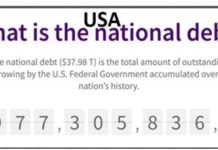
























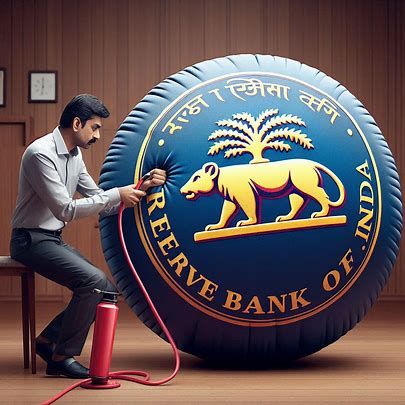

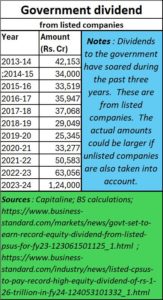
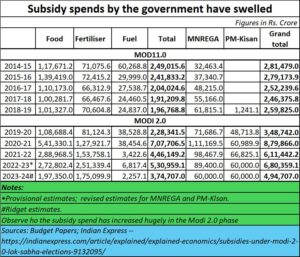
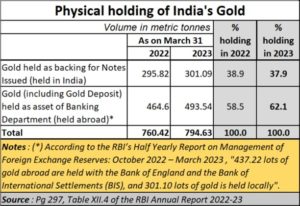
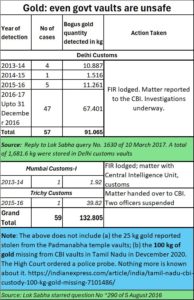
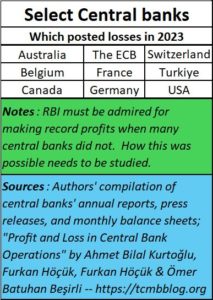







COMMENTS